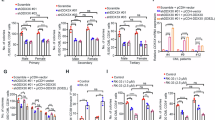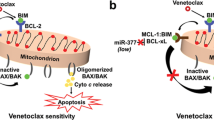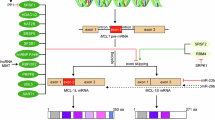Abstract
Selinexor, a first-in-class exportin1 (XPO1) inhibitor, is an attractive anti-tumor agent because of its unique mechanisms of action; however, its dose-dependent toxicity and lack of biomarkers preclude its wide use in clinical applications. To identify key molecules/pathways regulating selinexor sensitivity, we performed genome-wide CRISPR/Cas9 dropout screens using two B-ALL lines. We identified, for the first time, that paralogous DDX19A and DDX19B RNA helicases modulate selinexor sensitivity by regulating MCL1 mRNA nuclear export. While single depletion of either DDX19A or DDX19B barely altered MCL1 protein levels, depletion of both significantly attenuated MCL1 mRNA nuclear export, reducing MCL1 protein levels. Importantly, combining selinexor treatment with depletion of either DDX19A or DDX19B markedly induced intrinsic apoptosis of leukemia cells, an effect rescued by MCL1 overexpression. Analysis of Depmap datasets indicated that a subset of T-ALL lines expresses minimal DDX19B mRNA levels. Moreover, we found that either selinexor treatment or DDX19A depletion effectively induced apoptosis of T-ALL lines expressing low DDX19B levels. We conclude that XPO1 and DDX19A/B coordinately regulate cellular MCL1 levels and propose that DDX19A/B could serve as biomarkers for selinexor treatment. Moreover, pharmacological targeting of DDX19 paralogs may represent a potential strategy to induce intrinsic apoptosis in leukemia cells.
This is a preview of subscription content, access via your institution
Access options
Subscribe to this journal
Receive 12 print issues and online access
269,00 € per year
only 22,42 € per issue
Buy this article
- Purchase on SpringerLink
- Instant access to full article PDF
Prices may be subject to local taxes which are calculated during checkout






Similar content being viewed by others
Data availability
The processed data of CRISPR/Cas9 screens are available as a supplemental table. Raw data will be provided upon request.
References
Azmi AS, Uddin MH, Mohammad RM. The nuclear export protein XPO1 - from biology to targeted therapy. Nat Rev Clin Oncol. 2021;18:152–69.
Balasubramanian SK, Azmi AS, Maciejewski J. Selective inhibition of nuclear export: a promising approach in the shifting treatment paradigms for hematological neoplasms. Leukemia. 2022;36:601–12.
Nachmias B, Schimmer AD. Targeting nuclear import and export in hematological malignancies. Leukemia. 2020;34:2875–86.
Azizian NG, Li Y. XPO1-dependent nuclear export as a target for cancer therapy. J Hematol Oncol. 2020;13:61.
Lange A, Mills RE, Lange CJ, Stewart M, Devine SE, Corbett AH. Classical nuclear localization signals: definition, function, and interaction with importin alpha. J Biol Chem. 2007;282:5101–5.
Zhu ZC, Liu JW, Yang C, Zhao M, Xiong ZQ. XPO1 inhibitor KPT-330 synergizes with Bcl-xL inhibitor to induce cancer cell apoptosis by perturbing rRNA processing and Mcl-1 protein synthesis. Cell Death Dis. 2019;10:395.
Azmi AS, Aboukameel A, Bao B, Sarkar FH, Philip PA, Kauffman M, et al. Selective inhibitors of nuclear export block pancreatic cancer cell proliferation and reduce tumor growth in mice. Gastroenterology. 2013;144:447–56.
Etchin J, Sanda T, Mansour MR, Kentsis A, Montero J, Le BT, et al. KPT-330 inhibitor of CRM1 (XPO1)-mediated nuclear export has selective anti-leukaemic activity in preclinical models of T-cell acute lymphoblastic leukaemia and acute myeloid leukaemia. Br J Haematol. 2013;161:117–27.
Chari A, Vogl DT, Gavriatopoulou M, Nooka AK, Yee AJ, Huff CA, et al. Oral Selinexor-Dexamethasone for triple-class refractory multiple myeloma. N. Engl J Med. 2019;381:727–38.
Kalakonda N, Maerevoet M, Cavallo F, Follows G, Goy A, Vermaat JSP, et al. Selinexor in patients with relapsed or refractory diffuse large B-cell lymphoma (SADAL): a single-arm, multinational, multicentre, open-label, phase 2 trial. Lancet Haematol. 2020;7:e511–22.
Li W, Koster J, Xu H, Chen CH, Xiao T, Liu JS, et al. Quality control, modeling, and visualization of CRISPR screens with MAGeCK-VISPR. Genome Biol. 2015;16:281.
Colic M, Wang G, Zimmermann M, Mascall K, McLaughlin M, Bertolet L, et al. Identifying chemogenetic interactions from CRISPR screens with drugZ. Genome Med. 2019;11:52.
Lin DH, Correia AR, Cai SW, Huber FM, Jette CA, Hoelz A. Structural and functional analysis of mRNA export regulation by the nuclear pore complex. Nat Commun. 2018;9:2319.
Tieg B, Krebber H. Dbp5 - from nuclear export to translation. Biochim Biophys Acta. 2013;1829:791–8.
Nabet B, Ferguson FM, Seong BKA, Kuljanin M, Leggett AL, Mohardt ML, et al. Rapid and direct control of target protein levels with VHL-recruiting dTAG molecules. Nat Commun. 2020;11:4687.
Nakao F, Setoguchi K, Semba Y, Yamauchi T, Nogami J, Sasaki K, et al. Targeting a mitochondrial E3 ubiquitin ligase complex to overcome AML cell-intrinsic Venetoclax resistance. Leukemia 2023;37:1028–38.
Walensky LD. Targeting BAX to drug death directly. Nat Chem Biol. 2019;15:657–65.
Wickramasinghe VO, Laskey RA. Control of mammalian gene expression by selective mRNA export. Nat Rev Mol Cell Biol. 2015;16:431–42.
Kohler A, Hurt E. Exporting RNA from the nucleus to the cytoplasm. Nat Rev Mol Cell Biol. 2007;8:761–73.
Kwanten B, Deconick T, Walker C, Wang F, Landesman Y, Daelemans D. E3 ubiquitin ligase ASB8 promotes selinexor-induced proteasomal degradation of XPO1. Biomed Pharmacother. 2023;160:114305.
Nijhawan D, Fang M, Traer E, Zhong Q, Gao W, Du F, et al. Elimination of Mcl-1 is required for the initiation of apoptosis following ultraviolet irradiation. Genes Dev. 2003;17:1475–86.
Wendel HG, Silva RL, Malina A, Mills JR, Zhu H, Ueda T, et al. Dissecting eIF4E action in tumorigenesis. Genes Dev. 2007;21:3232–7.
Knight JRP, Alexandrou C, Skalka GL, Vlahov N, Pennel K, Officer L, et al. MNK inhibition sensitizes. Cancer Discov. 2021;11:1228–47.
Luedtke DA, Su Y, Liu S, Edwards H, Wang Y, Lin H, et al. Inhibition of XPO1 enhances cell death induced by ABT-199 in acute myeloid leukaemia via Mcl-1. J Cell Mol Med. 2018;22:6099–111.
Lapalombella R, Sun Q, Williams K, Tangeman L, Jha S, Zhong Y, et al. Selective inhibitors of nuclear export show that CRM1/XPO1 is a target in chronic lymphocytic leukemia. Blood. 2012;120:4621–34.
Culjkovic B, Topisirovic I, Skrabanek L, Ruiz-Gutierrez M, Borden KL. eIF4E is a central node of an RNA regulon that governs cellular proliferation. J Cell Biol. 2006;175:415–26.
Topisirovic I, Siddiqui N, Lapointe VL, Trost M, Thibault P, Bangeranye C, et al. Molecular dissection of the eukaryotic initiation factor 4E (eIF4E) export-competent RNP. EMBO J. 2009;28:1087–98.
Volpon L, Culjkovic-Kraljacic B, Sohn HS, Blanchet-Cohen A, Osborne MJ, Borden KLB. A biochemical framework for eIF4E-dependent mRNA export and nuclear recycling of the export machinery. RNA. 2017;23:927–37.
Sanda T, Lawton LN, Barrasa MI, Fan ZP, Kohlhammer H, Gutierrez A, et al. Core transcriptional regulatory circuit controlled by the TAL1 complex in human T cell acute lymphoblastic leukemia. Cancer Cell. 2012;22:209–21.
Tomoyasu C, Imamura T, Tomii T, Yano M, Asai D, Goto H, et al. Copy number abnormality of acute lymphoblastic leukemia cell lines based on their genetic subtypes. Int J Hematol. 2018;108:312–8.
Sasaki K, Yamauchi T, Semba Y, Nogami J, Imanaga H, Terasaki T, et al. Genome-wide CRISPR-Cas9 screen identifies rationally designed combination therapies for CRLF2-rearranged Ph-like ALL. Blood. 2022;139:748–60.
Bernadin O, Amirache F, Girard-Gagnepain A, Moirangthem RD, Levy C, Ma K, et al. Baboon envelope LVs efficiently transduced human adult, fetal, and progenitor T cells and corrected SCID-X1 T-cell deficiency. Blood Adv. 2019;3:461–75.
Yamauchi T, Masuda T, Canver MC, Seiler M, Semba Y, Shboul M, et al. Genome-wide CRISPR-Cas9 screen identifies leukemia-specific dependence on a Pre-mRNA metabolic pathway regulated by DCPS. Cancer Cell. 2018;33:386–400.e385.
Malone CF, Dharia NV, Kugener G, Forman AB, Rothberg MV, Abdusamad M, et al. Selective modulation of a pan-essential protein as a therapeutic strategy in cancer. Cancer Discov. 2021;11:2282–99.
Acknowledgements
We thank the members of the Department of Medicine and Biosystemic Science and the Division of Precision Medicine at Kyushu University for assistance and helpful discussion and Elise Lamar for critical reading of the manuscript. This work is supported in part by a Grant-in-Aid for Young Scientists (18K16089) (to YS), a Grant-in-Aid for Young Scientists (19K17859), a Research Grant from the KANAE Foundation, the MSD Life Science Foundation, the Yasuda Medical Foundation, the Mochida Memorial Foundation for Medical and Pharmaceutical Research, the Shinnihon Foundation of Advanced Medical Treatment Research, the Takeda Science Foundation (to TY), a Grant-in-Aid for Scientific Research (C)(23K07816) (to KS), a Grant-in-Aid for Young Scientists (22K16323) (to SH), a Grant-in-Aid for Scientific Research (S)(16H06391) (to K. Akashi), a Grant-in-Aid for Scientific Research (A) (17H01567, 20H00540), an AMED under grant number 18063889 and a Grant-in-Aid for Scientific Research (S)(20H05699) (to TM).
Author information
Authors and Affiliations
Contributions
TT, YS, TY, and TM designed CRISPR-Cas9 screen experiments. TT, YS, KS, TY, HI, TS. K. Akashi and TM reviewed CRISPR screen data. TT, KS, YS, TY, KS, SH, HI, and FN executed the CRISPR-Cas9 and cell biology experiments. K. Akahane and TI provided KOPN49 cells. TT and TM wrote the manuscript with help from all the authors.
Corresponding author
Ethics declarations
Competing interests
The authors declare no competing interests.
Ethics approval and consent to participate
All experiments involving human material (leukemia cell lines) were performed in accordance with the Declaration of Helsinki under an approved Kyushu university institutional research protocol (#4-142). Informed consent from human research participants: not applicable.
Additional information
Publisher’s note Springer Nature remains neutral with regard to jurisdictional claims in published maps and institutional affiliations.
Supplementary information
Rights and permissions
Springer Nature or its licensor (e.g. a society or other partner) holds exclusive rights to this article under a publishing agreement with the author(s) or other rightsholder(s); author self-archiving of the accepted manuscript version of this article is solely governed by the terms of such publishing agreement and applicable law.
About this article
Cite this article
Terasaki, T., Semba, Y., Sasaki, K. et al. The RNA helicases DDX19A/B modulate selinexor sensitivity by regulating MCL1 mRNA nuclear export in leukemia cells. Leukemia 38, 1918–1928 (2024). https://doi.org/10.1038/s41375-024-02343-2
Received:
Revised:
Accepted:
Published:
Issue Date:
DOI: https://doi.org/10.1038/s41375-024-02343-2



